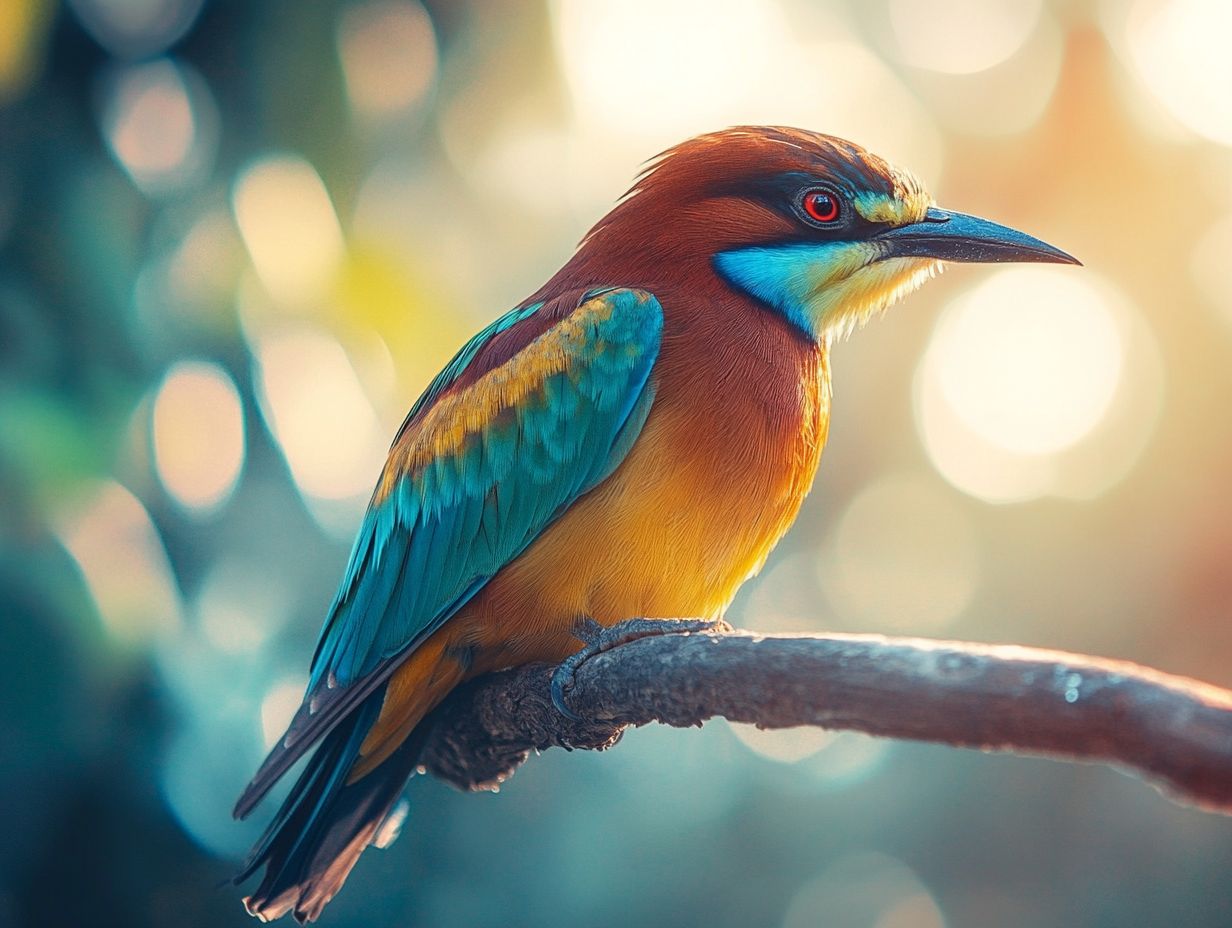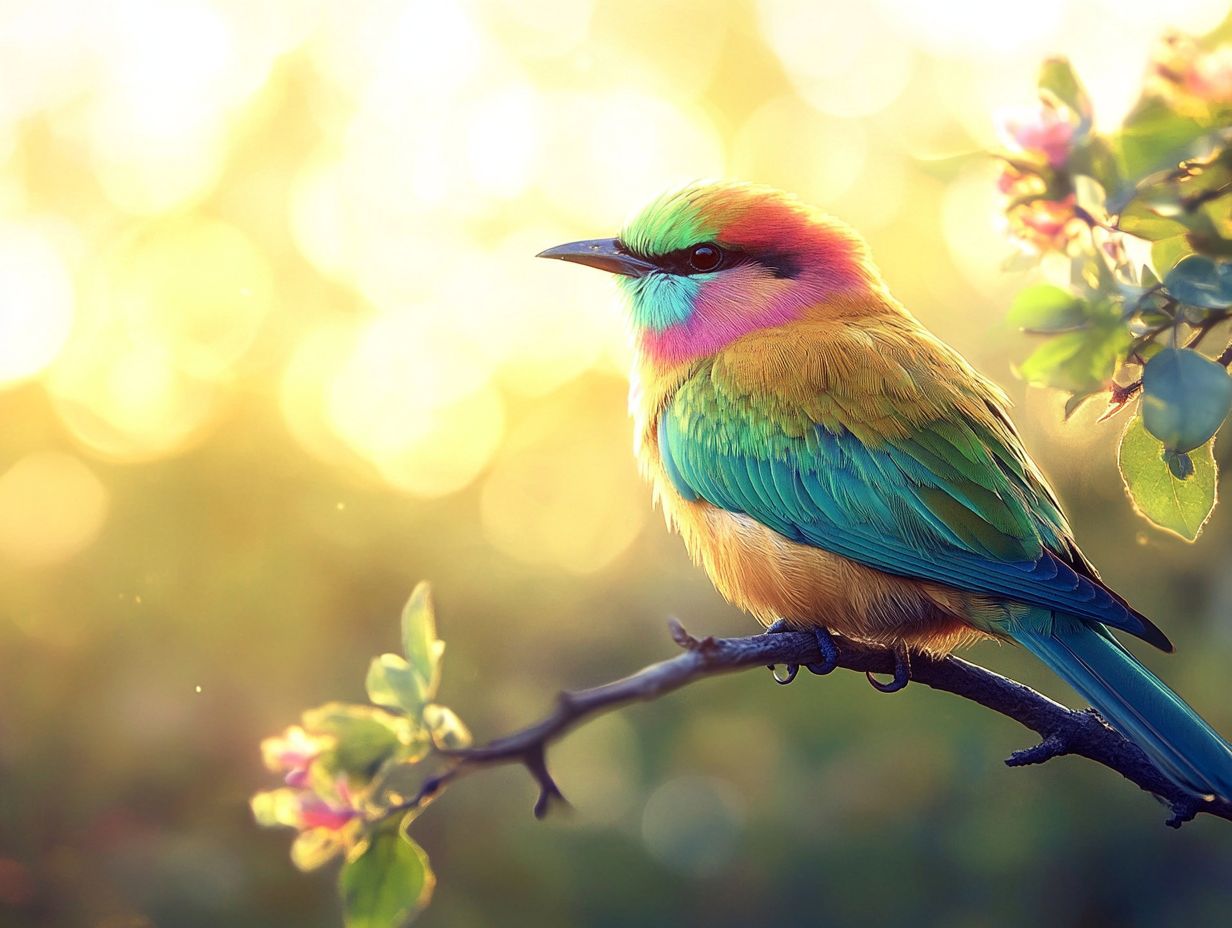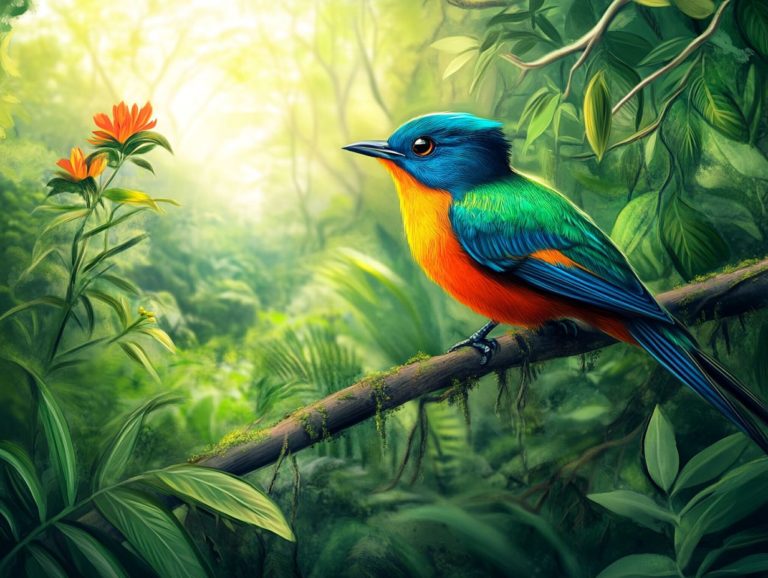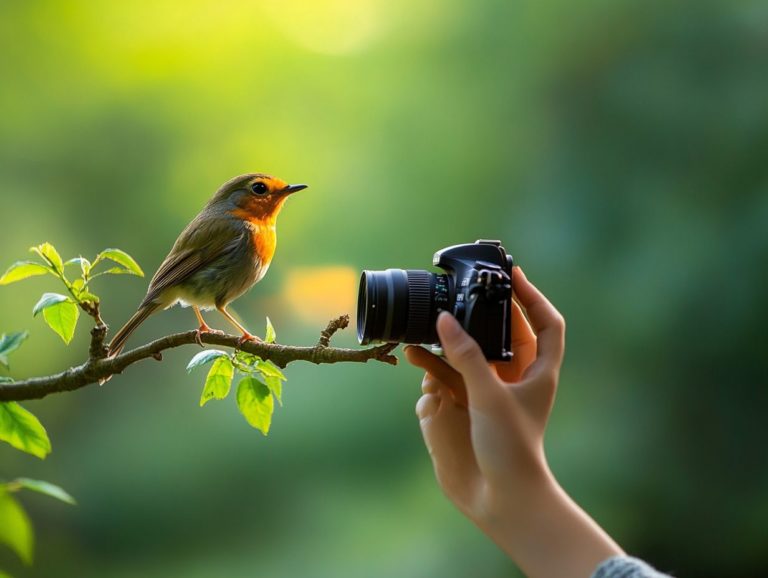How to Use Natural Light in Bird Photography
Bird photography offers a truly enchanting experience, but the secret to capturing stunning images often hinges on your understanding and harnessing light.
This article delves into the significance of light in photography, highlighting various types of natural light that can elevate your bird images. You ll discover practical tips for positioning yourself and adjusting your camera settings to maximize the available light.
Additionally, recognizing how different lighting scenarios affect your subject can enhance your compositional techniques. You will find strategies to tackle challenges posed by harsh sunlight or low-light conditions and backlighting techniques.
No matter if you’re a beginner or a seasoned photographer, mastering natural light will elevate your bird photography, especially in places like Costa Rica!
Contents
- Key Takeaways:
- Understanding Natural Light in Bird Photography
- Types of Natural Light for Bird Photography
- Tips for Using Natural Light in Bird Photography
- Challenges and Solutions for Using Natural Light
- Frequently Asked Questions
- How to Use Natural Light in Bird Photography?
- Why is natural light important in bird photography?
- What are the best times of day to use natural light in bird photography?
- How can I control the natural light in my bird photography?
- What are some tips for using natural light in different weather conditions?
- How can I use natural light to create a specific mood in my bird photos?
Key Takeaways:

- Natural light is crucial in bird photography for capturing stunning and natural-looking images.
- Direct sunlight, diffused light, and golden hour are the three main types of natural light to consider when photographing birds.
- Positioning yourself and the subject, adjusting camera settings, and utilizing environmental elements are key tips for using natural light effectively in bird photography.
Understanding Natural Light in Bird Photography
Understanding natural light is essential in bird photography, as it greatly affects the quality of your images and knowing the best time of day for bird photography can enhance your results.
Light, particularly sunlight, plays a crucial role in shaping how colors and shadows manifest in your photographs. Whether you re capturing the intricate details of a Scarlet Macaw’s feathers or the delicate hues of an American Wigeon, your ability to harness natural light can elevate your wildlife photography to new heights.
Recognizing how different lighting scenarios affect your subject can enhance your compositional techniques, transforming your photography journey into a rewarding experience that serves the vital purpose of conservation awareness.
The Importance of Light in Photography
Light serves as the cornerstone of photography, affecting everything from exposure to composition. Mastering its use is vital for you to capture stunning images.
The interaction between ambient light and your subject can elevate your bird photography, highlighting the vividness of plumage and the intricate details of feather patterns. Look for catchlights, the tiny reflections in a bird’s eyes, to add life to your images and draw viewers into a deeper emotional connection with your subject.
Utilizing shadows effectively can add layers of depth, enriching the three-dimensional quality of your photographs. By employing smart composition techniques and leveraging various light sources and angles, you can create dynamic and engaging scenes. This approach transforms a simple snapshot into a true work of art.
Types of Natural Light for Bird Photography
The different types of natural light can profoundly influence the quality of your bird photography, presenting you with exceptional opportunities to capture the stunning essence of wildlife. For instance, learning techniques for photographing birds in flight can enhance your skills in various settings.
From the gentle glow of the golden hour to the bold illumination of midday sunlight, each lighting condition offers its own unique charm that can elevate your images to new heights.
Direct Sunlight
Direct sunlight can be both a blessing and a curse in bird photography, offering vibrant colors while casting harsh shadows that may detract from the overall image quality.
To effectively navigate this duality, consider the time of day and the sun’s position. Early morning or late afternoon light provides a softer glow, illuminating feather details without the disruptive contrasts often encountered during midday.
Use a lower ISO setting for better image clarity. This reduces noise, providing crisper visuals even in bright conditions. Employing reflectors to redirect sunlight can help balance shadows and highlights, resulting in more evenly lit compositions.
Positioning yourself at an angle to the light can also mitigate unwanted glare, ensuring that every bird you capture is showcased in its best light.
Don t miss the chance to capture breathtaking images during the golden hour! Grab your camera and start exploring the beauty of natural light today!
Diffused Light

Diffused light, often gracing the scene on overcast days, softens shadows and creates a beautifully even exposure. This atmospheric condition is perfect for capturing the delicate details of birds in their natural habitats.
With this type of lighting, you minimize harsh contrasts and enhance the subtleties of color. You can reveal the intricate patterns of feathers and the serene expressions of your subjects. Embracing ambient light allows you to achieve a flattering representation of birds while avoiding blown-out highlights or overly dark shadows.
To make the most of this lighting scenario, consider these expert recommendations:
- Scout locations with dense tree cover
- Seek out open fields that maximize diffusion
Positioning yourself during the early morning or late afternoon can give you that enchanting glow, fully showcasing the beauty of avian life.
Golden Hour Light
The golden hour, with its warm, soft sunlight, presents an enchanting backdrop for your bird photography. It enhances colors and creates a stunning bokeh effect in the background, which is the blurred effect in your photos.
During this magical time, sunlight bathes the feathers of the birds in a gentle glow, revealing vibrant hues that transform even the most common species into something exquisite. The low angle of the sun allows you to capture long shadows, adding depth and dimension to your images.
By positioning yourself thoughtfully, you can fully leverage this ideal lighting to create captivating compositions.
Emphasizing the interplay between light and shadow elevates the aesthetic appeal of your photographs. You’ll create striking visuals that celebrate both the subject and its natural habitat.
Tips for Using Natural Light in Bird Photography
Effectively harnessing natural light in bird photography requires careful planning and a deep understanding of both your camera settings and the surrounding environment. For those interested in capturing stunning images, learning specific techniques for nighttime bird photography ensures that each shot highlights the beauty of the birds while capturing the essence of their habitat.
Positioning Yourself
Positioning yourself and the subject with precision is essential for achieving the exposure you desire while minimizing shadows in bird photography.
To capture breathtaking images, carefully consider your angles and distances. Experimenting with different viewpoints unveils unique perspectives that accentuate the bird’s features. Maintaining a moderate distance often provides clearer detail while avoiding distracting backgrounds.
Understanding the direction of light is crucial. Position yourself so that soft, natural light bathes the subject, enhancing textures and colors while softening harsh shadows. This thoughtful approach elevates your photography.
It creates an inviting atmosphere that truly brings the essence of the bird to life.
Camera Settings
Adjusting your camera settings is essential for navigating the ever-changing natural light and low lighting conditions. This ensures your bird photography remains sharp and vibrant, no matter the environment.
This adaptability elevates the quality of your images and gives you the power to seize fleeting moments during the golden hours of dawn and dusk, when wildlife tends to be most active.
Exposure is crucial for striking the perfect balance between light and shadow. It allows you to capture exquisite details in plumage and landscapes.
Shutter speed becomes your ally in freezing the swift movements of birds in flight. Quick adjustments are necessary to prevent any unwanted blur. Meanwhile, fine-tuning ISO sensitivity is key; selecting the right level ensures image clarity in low light or high-contrast situations.
This gives you the confidence to succeed even in challenging conditions.
Utilizing Natural Elements

Using natural elements in your bird photography enhances composition. It helps create a story that connects the bird to its environment.
By thoughtfully integrating foliage, water, and background elements, you can evoke a sense of place and harmony in your images. For instance, using greenery creates a vibrant contrast to the colorful plumage of the birds and frames them beautifully. This guides the viewer’s eye right where you want it.
Capture stunning reflections in water! They add amazing symmetry and depth to your photos.
These techniques enrich the visual appeal and convey the habitat. This makes your photographs more engaging and immersive. With a strategic approach, even simple bird portraits can transform into captivating storytelling images.
Challenges and Solutions for Using Natural Light
Natural light offers remarkable opportunities for bird photography. However, it also brings challenges, including harsh light and low-light conditions. You’ll need effective tips for photographing rare bird species to navigate these obstacles and capture stunning images.
Dealing with Harsh Light
Harsh light in bird photography can be a challenge. But you have techniques to mitigate its effects and elevate your images.
One effective approach is to use reflectors to bounce soft light onto your subject. This helps soften the harsh contrasts between bright highlights and dark shadows.
Consider using various filters, like those that reduce glare or limit light, to control sunlight intensity. This allows for a more balanced exposure and better subject visibility.
Adjusting your camera settings like lowering the ISO or choosing a faster shutter speed can refine your shots. This ensures you capture details without washing out vibrant colors.
By implementing these strategies and understanding shadows and light, you can instantly create stunning images, showcasing every feather beautifully.
Overcoming Low Light Conditions
Overcoming low light conditions in bird photography requires a blend of technical expertise and creative solutions. Understanding the basics of bird photography composition ensures you capture quality images even when natural light is scarce.
This balancing act often calls for artificial light sources, like external flashes or continuous LED lights. Position them carefully to illuminate your subject without causing alarm.
By making precise ISO adjustments, you can capture more detail in dim settings while avoiding grainy images. A fast lens allows more light into your camera, significantly enhancing your results.
Incorporating techniques like stabilizing your camera with a tripod and using longer exposure times can elevate image clarity. This transforms challenging lighting conditions into golden opportunities for breathtaking captures, especially during the golden hour.
Frequently Asked Questions
How to Use Natural Light in Bird Photography?

Natural light, including side lighting and backlighting techniques, is key to capturing stunning bird photographs. For a deeper dive, check out these tips on understanding exposure for bird photography and learn how to use natural light effectively.
Why is natural light important in bird photography?
Natural light is crucial in bird photography! It makes your photos vibrant and highlights the bird’s colors and details, which is essential for wildlife photography. Understanding the impact of weather on bird photography can further enhance your shooting experience.
What are the best times of day to use natural light in bird photography?
The best times for bird photography are during the golden hours: the first hour after sunrise and the last hour before sunset. These times offer soft, warm light that creates a stunning glow in your photos.
How can I control the natural light in my bird photography?
Take charge of natural light by adjusting your camera’s settings like shutter speed and ISO. You can also use reflectors to bounce light or diffusers to soften it.
What are some tips for using natural light in different weather conditions?
In sunny weather, shoot in the shade to avoid harsh shadows. On cloudy days, embrace the soft light for beautiful results.
During golden hour, position yourself to capture that warm, golden light. In low light, increase your ISO and open your lens wider to let in more light, adding artificial light if needed.
How can I use natural light to create a specific mood in my bird photos?
Use light direction to set the mood in your photos. Backlighting gives an ethereal feel, while sidelighting adds drama and depth.
Front lighting is more traditional and highlights the bird’s details effectively.






